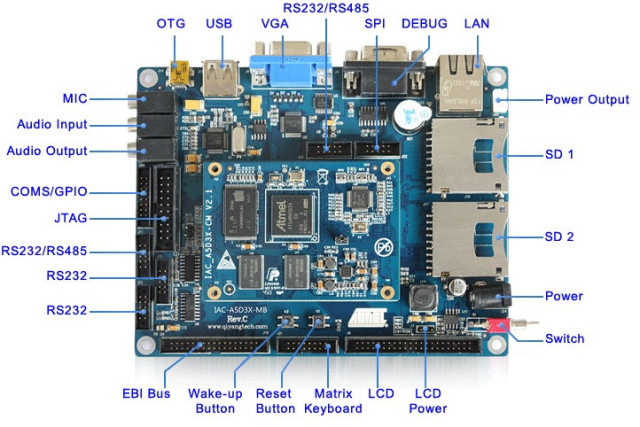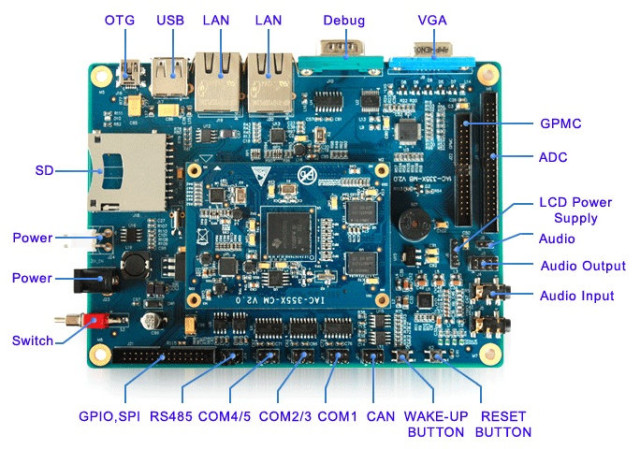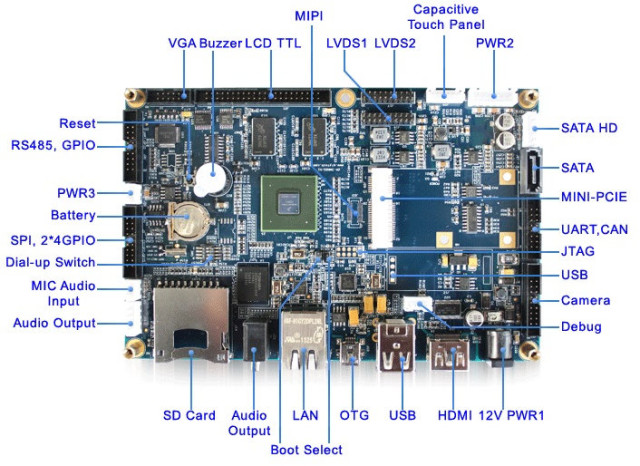Hangzhou Qiyang Technology () is a company based in Hangzhou, China, that provides embedded hardware solutions such as low power development boards and computer-on-modules. I’ve recently come across the company, and they have boards for various ARM based SoCs, but I’ve received details about three of their latest industrial development boards powered by Atmel SAMA5D3 Cortex A5 processor, Texas Instruments Sitara AM335x Cortex A8 SoC, and Freescale i.MX6 single and multi-core ARM Cortex A9 SoCs. Let’s have a look.
Qiyang QY-A5D3XEK – Atmel SAMA5D3 Development Board

The development kit is comprised of a base board (IAC-A5D3X-MB) and a computer-on-module (ICA-A5D3X_CM) with the following hardware specifications:
- Processor – Atmel SAMA5D3 ARM Cortex A5 @ 536 MHz (Either SAMA5D31, SAMA5D33, SAMA5D34 or SAMA5D35)
- System Memory – 256 MB DDR2 @ 333 MHz
- Storage – 256MB NAND flash + 2MB dataflash on CoM, 2x SD card slot on baseboard
- Video Output – VGA, and 16-bit TFT LCD (24-bit compatible) interface up to 2048×2048.
- Audio – AC97 codec, 1x mic input, 1x LINE in, 1x LINE out
- Connectivity – 10/100M Ethernet
- Serial Ports – 5x RS232 ports including one as a debug port (DB9), 2x RS232/RS485 ports
- USB – 1x USB 2.0 host ports, 1x micro USB OTG port
- Other expansions headers – GPIO, PWM, SPI, I2C, JTAG, EBI CAN bus, 8×8 keyboard matrix header (also used as 4-wire resistive touchscreen I/F)
- Misc – Wake-up and reset buttons
- Power Supply – +12V, can support +6V to 23V input
- Dimensions – CoM: 74 x 53 x 1.5 mm; Baseboard: 142.5 x 112 mm
- Temperature Range – -20 to 70 C (operating)
The company provides support for Linux 3.6.9 + Qt4, as well as Android 4.0 for the board which are provided with the documentation and tools on a DVD. Qiyang also offers variousLCD panels compatible with their board from 4.3″ to 10.4″, as well as optional TTL to LVDS or TTL to VGA modules.
IAC-A5D3X-KIT is available now, with a sample price of $180 per unit, You can find a bit more information on the product page, and much more details on the hardware reference manual.
Qiyang IAC-335X – Texas Instruments AM335x Development Board

IAC-335X development kit is also comprised of a CoM (IAC-335X-CM) and a base board (IAC-335X-MB) with specifications very similar to the Atmel board:
- Processor – Texas Instruments AM3354 Cortex A8 CPU @ 720 MHz
- System Memory – 256MB DDR2
- Storage – 256MB NAND Flash + 2MB dataflash on CoM. SD card slot on baseboard.
- Video Output – VGA, and 16-bit TFT LCD (16- and 24-bit compatible) interface up to 1366×860.
- Audio – McASP audio interface, 1x mic input, 1x LINE in, 1x LINE out
- Connectivity – 2x 10/100/1000M Ethernet
- Serial Ports – 5x RS232 ports including one as a debug port (DB9), 2x RS232/RS485 ports
- USB – 1x USB 2.0 host ports, 1x micro USB OTG port
- Other expansions headers – GPIO, 16-bit GPMC, JTAG, SPI, CAN 2.0A&B bus, 4-wire resistive touchscreen input interface.
- Misc – Wake-up and reset buttons, RTC, buzzer
- Power Supply – +12V, can support +4.75V to +18V input
- Dimensions – CoM: 74 x 53 x 1.5 mm; Baseboard: 142 x 112 mm
- Temperature Range – -20 to 70 C (operating)
The company’s SDK includes Linux 3.2.10 + Qt4, and Android 4.0.3, as well as documentation and tools (arago compiler, Virtual machine for development…). All files are provided via a DVD shipped with the kit. Qiyang can provide the same optional 4.3″ to 10.4″ LCD panels, and TTL to LVDS/VGA modules as used with their SAMA5D3 boards.
IAC-335x-KIT is available now for $210 (sample price). More details can be found on the product page, as well as the hardware reference manual.
Qiyang QY-IMX6-V – Freescale i.MX6 Solo/Dual/Quad Development Board

Contrary to the other two their Freescale i.MX6 development kit is a single board computer with the following technical details:
- SoC – Freescale i.MX6 Dual (2x ARM CortexA9) @ 1 GHz with Vivante GC2000 3D GPU by default. i.MX6 Solo and Quad are available as options
- System Memory – 1GB DDR3
- Storage – 4GB eMMC, SD card slot, and SATA II interface.
- Video Output
- HDMI 1.4 connector
- VGA header
- 18-bit TFT LCD (16- and 24-bit compatible) interface up to 1920×1200
- 2-channel LVDS interfaces with each channel supporting up to 1920×1200
- MIPI/DSI interface up to 1 Gbps
- Touchscreen I/F – 4-wire for resistive touch screen, I2C for capacitive touchscreen.
- Audio – 1x mic input, 2x audio output
- Connectivity – 1x 10/100/1000M Ethernet using Atheros AR8035 chip
- Serial Ports – 5x RS232 ports including one as a debug port, 2x RS232/RS485 ports (TBC as there seems to be less on the board pic)
- USB – 1x USB 2.0 host port, 1x micro USB OTG port, 1x USB header
- Camera – Header with support for OV5642 camera module
- Other expansions headers – GPIO, JTAG, SPI, CAN
- Expansion slot – 1x mini PCIe 2.0, 1x SIM card interface
- Misc – Reset buttons, “dial-up” switch, Boot select switch, RTC + battery, buzzer, watchdog
- Power Supply – +12V, can support +4.75V to +18V input
- Dimensions – 160 x 105 mm
- Temperature Range – -20 to 70 C (operating)
There’s no mention of the Linux and Android versions officially supported by the board, but I’ve been old as with other devkit all source code, tools, and documentation should be available on a DVD provided as part of the kit.
Qiyang QY-IM6S-V1.2 board samples sell for $195. I could not find a product page on the company website, but you can find out more in QY-IMX6S hardware manual.
You could also check out some other (older) boards on the company website.

Jean-Luc started CNX Software in 2010 as a part-time endeavor, before quitting his job as a software engineering manager, and starting to write daily news, and reviews full time later in 2011.
Support CNX Software! Donate via cryptocurrencies, become a Patron on Patreon, or purchase goods on Amazon or Aliexpress




